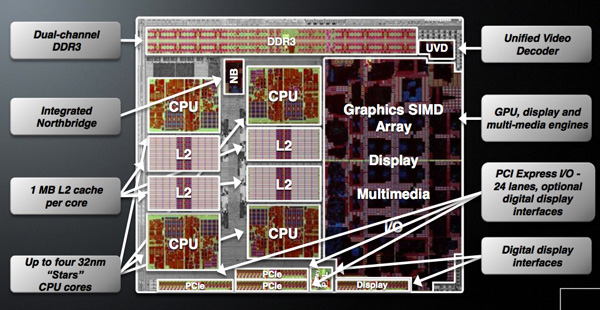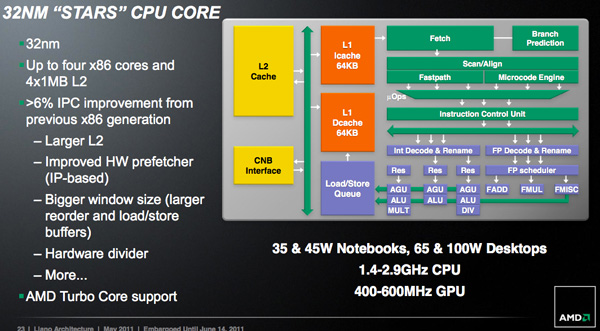The AMD Llano Notebook Review: Competing in the Mobile Market
by Jarred Walton & Anand Lal Shimpi on June 14, 2011 12:01 AM ESTThe Llano A-Series APU
Although Llano is targeted solely at the mainstream, it is home to a number of firsts for AMD. This is AMD's first chip built on a 32nm SOI process at GlobalFoundries, it is AMD's first microprocessor to feature more than a billion transistors, and as you'll soon see it's the first platform with integrated graphics that's actually worth a damn.
AMD is building two distinct versions of Llano, although only one will be available at launch. There's the quad-core, or big Llano, with four 32nm CPU cores and a 400 core GPU. This chip weighs in at 1.45 billion transistors, nearly 50% more than Sandy Bridge. Around half of the chip is dedicated to the GPU however, so those are tightly packed transistors resulting in a die size that's only 5% larger than Sandy Bridge.
| CPU Specification Comparison | ||||||||
| CPU | Manufacturing Process | Cores | Transistor Count | Die Size | ||||
| AMD Llano 4C | 32nm | 4 | 1.45B | 228mm2 | ||||
| AMD Llano 2C | 32nm | 2 | 758M | ? | ||||
| AMD Thuban 6C | 45nm | 6 | 904M | 346mm2 | ||||
| AMD Deneb 4C | 45nm | 4 | 758M | 258mm2 | ||||
| Intel Gulftown 6C | 32nm | 6 | 1.17B | 240mm2 | ||||
| Intel Nehalem/Bloomfield 4C | 45nm | 4 | 731M | 263mm2 | ||||
| Intel Sandy Bridge 4C | 32nm | 4 | 995M | 216mm2 | ||||
| Intel Lynnfield 4C | 45nm | 4 | 774M | 296mm2 | ||||
| Intel Clarkdale 2C | 32nm | 2 | 384M | 81mm2 | ||||
| Intel Sandy Bridge 2C (GT1) | 32nm | 2 | 504M | 131mm2 | ||||
| Intel Sandy Bridge 2C (GT2) | 32nm | 2 | 624M | 149mm2 | ||||
Given the transistor count, big Llano has a deceptively small amount of cache for the CPU cores. There is no large catch-all L3 and definitely no shared SRAM between the CPU and GPU, just a 1MB private L2 cache per core. That's more L2 cache than either the 45nm quad-core Athlon II or Phenom II parts.

Intel's Sandy Bridge die is only ~20% GPU
The little Llano is a 758 million transistor dual-core version with only 240 GPU cores. Cache sizes are unchanged; little Llano is just a smaller version for lower price points. Initially both quad- and dual-core parts will be serviced by the same 1.45B transistor die. Defective chips will have unused cores fused off and will be sold as dual-core parts. This isn't anything unusual, AMD, Intel and NVIDIA all use die harvesting as part of their overall silicon strategy. The key here is that in the coming months AMD will eventually introduce a dedicated little Llano die to avoid wasting fully functional big Llano parts on the dual-core market. This distinction is important as it indicates that AMD isn't relying on die harvesting in the long run but rather has a targeted strategy for separate market segments.
Architecturally AMD has made some minor updates to each Llano core. AMD is promising more than a 6% increase in instructions executed per clock (IPC) for the Llano cores vs. their 45nm Athlon II/Phenom II predecessors. The increase in IPC is due to the larger L2 cache, larger reorder and load/store buffers, new divide hardware, and improved hardware prefetchers.
On average I measured around a 3% performance improvement at the same clock speed as AMD's 45nm parts. Peak performance improved up to 14% however most of the gains were down in the 3—5% range. This is arguably the biggest problem that faces Llano. AMD's Phenom architecture debuted in 2007 and was updated in 2009. Llanos cores have been sitting around for the past 3-4 years with only a mild update while Intel has been through two tocks in the same timeframe. A ~6% increase in IPC isn't anywhere near close enough to bridge the gap left by Nehalem and Sandy Bridge.
Note that this comparison is without AMD's Turbo Core enabled, but more on that later.












177 Comments
View All Comments
Dustin Sklavos - Tuesday, June 14, 2011 - link
I disagree emphatically. Having used Atom-based and E-350-based netbooks (and let's not kid ourselves, the E-350 is a netbook chip), the E-350 machines just feel snappier. I'd never buy an Atom-based computer, but I love the E-350.ppeterka - Tuesday, June 14, 2011 - link
Absolutely agree with Dustin... Recently bought an E-350 to replace my wife's painfully struggling Atom n455 netbook. The user experience went through the roof. My wife is happier than ever (and that's a very good thing, and a very good benchmark! :))) )She is a "not-professional-but-quite-demanding" user. (20-30 browser tabs, Office, and video streaming at once, Twitter with multiple accounts, and so on). She used to have a C2D T6600 + GeForce 310 (or 210 , don't exactly remember) Toshiba notebook too, but since we acquired the Brazos one, she didn't turn the old one on. Have to sell it now...
I know, Brazos is weak if compared to anything other than Atom. But magically it manages to absolutely fill its role. Hats off to AMD on that one!
Broheim - Tuesday, June 14, 2011 - link
I wouldn't describe your wife as a "quite demanding" user.Browser tabs don't take up CPU cycles once loaded (unless the page uses AJAX, and even then a simple http request isn't a daunting task even for a 20 year old processor) and only uses a little bit of memory.
I'd call MS Office pretty basic computer usage .
today video decoding is almost always hardware accelerated, so most of the work is offloaded onto the GPU (where E-350 has the upper hand).
but I digress.
just look at the benchmarks, there isn't much of a difference between the E-350 and a D525 (or similar) in CPU intensive tasks...
any percieved "snappiness" on your part is down to other aspects of the system (such as HDD for instance).
Iketh - Tuesday, June 14, 2011 - link
are you forgetting single-threaded results?Broheim - Wednesday, June 15, 2011 - link
1 synthetic benchmark... big whoop.they are equal in everything else
duploxxx - Friday, June 17, 2011 - link
perhaps actually read some reviews, they all agree on one thing, the system feels much smoother for daily tasks. I am sure you don't have both or used both so have no idea what you are talking about. just launching OS or any application is enough to notice the difference. I owned a n570 so i do know.Broheim - Monday, June 27, 2011 - link
that is subjective opinion and the only subjective opinion that matters to me is my own. You fail to realize that the perceived user experience is a product of the system as a whole and not just a single component....sinigami - Wednesday, June 15, 2011 - link
i've only gotten to run two single threaded benchmarks on the E-350, and out of those two, the bench that showed the biggest improvement over the Atom was CPUMark99, by 6% percent, over an N455 in an MSI netbook.Granted, i didn't get to run all four of my single-threaded benchmarks on the E350 against the N455, but i will, and soon.
maroon1 - Tuesday, June 14, 2011 - link
Atom N455 is single core.There are new and better Atoms like N550
sinigami - Wednesday, June 15, 2011 - link
and, BTW, the N455 even plays 720p MKV. Who would expect any more than that out of a $250 netbook?But at the price of the E-350, i do expect more. And by more, i mean more than just ION level graphics that might let you send out 1080p to an external display. I want some significant CPU horsepower.